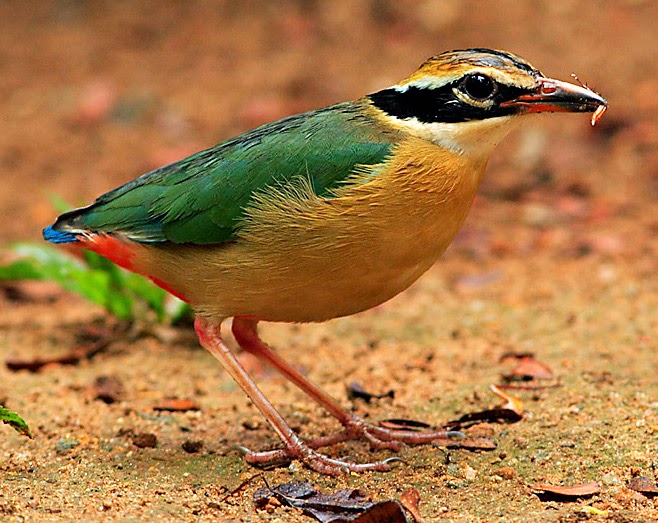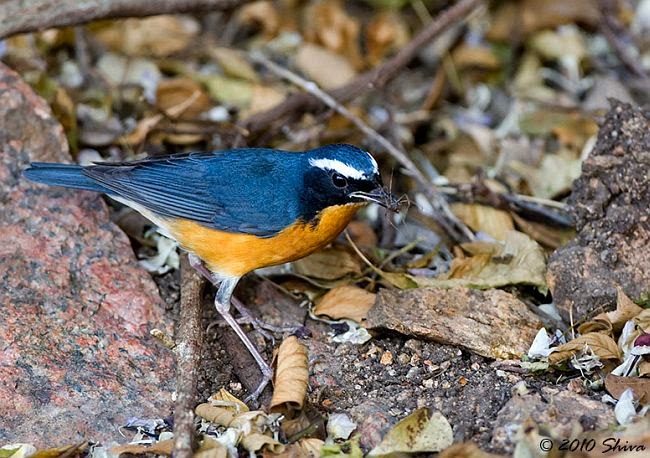The name of this bird in Tamil which is derived from its behaviour is Kathelachi (wind-blown) and Arumani Kuruvi (six-o’clock bird). Calling at dawn and dusk occurs on the wintering grounds, thus the reason for its Tamil name which translates as the ‘six-o’clock bird’.
It is a small stubby-tailed bird that is mostly seen on the floor of forests or under dense undergrowth, foraging on insects in leaf litter. It has long, strong legs, a very short tail and stout bill, with a buff coloured crown stripe, black coronal stripes, a thick black eye stripe and white throat and neck. The upperparts are green, with a blue tail, the underparts buff, with bright red on the lower belly and vent.
 |
| Illustration from Alfred Brehm's Tierleben |
The four species of Asian Pitta that share buff underparts and conspicuous blue wing patches are the – Indian Pitta, Pitta Brachyura, Fairy Pitta, P. Nympha, Blue-winged Pitta, P. Moluccensis, and Mangrove Pitta, P. Megarhyncha – these four are clearly closely related species that sometimes overlap. To read in full about the identification of the various species of Pittas go to this link here.
 |
| Adult Pitta feeding |
The Indian Pitta is a medium-sized passerine bird the size of a small Mynah and found throughout India. It is mainly terrestrial and roosts in trees. It affects wooded country and is fond of dry water channels and ravines with tangled undergrowth. The Indian Pitta (also sometimes known as the Bengal Pitta), hops along like Thrush turning over dead leaves and digging into damp earth for insects and grubs which comprise its food. This bird feed on insects and other small invertebrates that are usually picked up from the ground or leaf litter. They have also been noted to take kitchen food scraps from the ground.
 |
| Bird singing |
 |
| Tail pattern photo by Kavisuman |
The Indian Pitta’s call is a clear short double whistle (of monosyllabic notes) ‘wheeet-tieu’ or ‘wieet-pyou’ or occasionally, a triple note ‘hh-wit-wiyu’. When calling the head is thrown back and the bill is pointed upwards. Its stumpy tail wags slowly and deliberately up and down.
 |
| Pitta making Nest |
Beautiful video showing the nesting Indian Pitta
 |
| Young Chicks in Nest |
 |
| Immature Pitta |
The Indian Pittas' local migrations are controlled by the SW monsoon. It roosts in trees and breeds during the south-west monsoon from May to August. The nest is a globular structure with a circular opening on one side built on the ground or on low branches. It is made up of dry leaves and grasses. The clutch is four to five eggs which are very glossy white and spherical with spots and speckles of deep maroon or purple.
 |
| Indian Pitta photo by P. Maheria |
************************
The below is an extract from a Book published in 1915 by a Western Ornithologist Frank Finn, resident for many years in North India near Calcutta. Many of his observations are droll and charming.
The Pittas
By Frank Finn
Garden and Aviary Birds of India (1915)
“This bird is found all through the warm parts of India, usually keeping to jungle though coming into gardens. They are about equal to a small Mynah in size, but in form and action more resemble the Thrush, with which they used to be classed. Their bills are rather stouter than an ordinary Thrush’s and their legs longer, while their tails are absurdly short and hardly noticeable.
In colour it is green above and buff below, with the head broadly streaked with black and drab, the throat white, and a patch under the tail scarlet. On the shoulder of the wing, and just above the root of the very short tail, are patches of intense shining sky-blue, and the flight feathers of the wings are black with a large white patch, as in the House Mynah. The bill is salmon-coloured and black, and the legs flesh-coloured, the eyes being dark brown.
Their ordinary movements are very graceful, and their gestures when excited are most amusing. Sometimes they will stand bolt upright, at others crouch down; and in either position they will often expand their wings, an action which has a most ludicrously oratorical appearance when they are standing up. With other birds they seem to be quite harmless, even with much smaller ones, but they are liable to fight savagely amongst themselves.
They live mostly on the ground, and do not perch much; but unlike most ground birds, they never run, but always hop, though they get along in this manner very swiftly and gracefully. They are fairly good flyers but usually keep low down. They seem to feed entirely on insects and other small animals and they are not at all sociable, being usually seen alone. They do not sing, but their plumage is usually remarkably brilliant and beautiful, and shows a great variety of patterns. The bird builds a big round nest of twigs and leaves. This is either actually on the ground or on a low branch. The eggs are lustrous white with deep red and purple spots.
The cock and hen are alike, and the young closely resemble them, being merely duller in colour below, where there is also a slight dark edging to the feathers.
The Indian Pitta (or Bengal Pitta) is known as “nine colours” and is the most familiar of all pittas being found all over Indian and Ceylon. It is to a certain extent migratory, going south in the Winter and returning to the northern provinces in the hot weather and rains, though some birds appear never to change their quarters."


















































